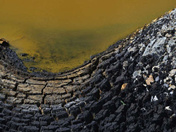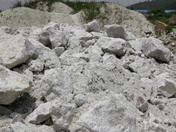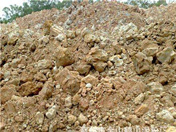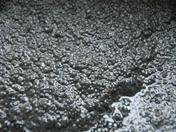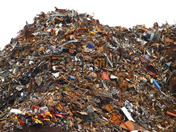Zhengzhou Taida welcome your visiting to our website!
 SITEMAP|
中文站|
CONTACT US|
ONLINE MESSAGE
SITEMAP|
中文站|
CONTACT US|
ONLINE MESSAGE
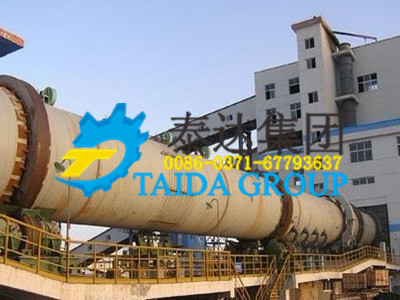
Chemical rotary kiln
Specifications:
Chemical rotary kiln is one of the commonest type rotary kilns. It is mainly divided into two kinds, dry rotary kiln and wet rotary kiln. This equipment holds simple operation and simple design.
Application Range:Building material, metallurgy, chemical industry, electrical power and etc.
Applicable Materials:cement, Lime,Refractories, Metakaolin, Titanium dioxide, Alumina, Vermiculite, Iron ore pellets.






Low energy consumption
Our rotary kiln adopts reasonble running parameter; coal and electricity consumption can be 20% to 30% lower than common dryer.
High output capacity
Output capacity can be increased by more than 20%. Taida rotary kiln has been widely applied to mining and metallurgy industry.
With high automation level
The whole production line needs only one person to supervise. finished products can be directly packed and stored.
More durable
Service life can last for 8 to 10 years. with good maintenance, it can be used for longer time.
With less quick-wear parts.
Important parts adopt advanced thermal processing technology. Replace period can reach 5000 hours.
More environment friendly
Adopts multi-class dust collecting method, clean exhaust gas emission can totally meet national standard.
1. Support device: it adopts advanced main axial structure; it is equipped with automatic temperature measuring equipment and electrical heating device; there is also flow support for your option.
2. Catch wheel device: It is divided into two kinds, mechanical wheel and hydraulic wheel which is equipped with advanced control system.
3. Transmission device: chemical rotary kiln is equipped with single driving and double driving; direct current motor and variable frequency motor. High efficiency and energy saving;
4. Seal device: according to different design and multiple seal type, there are different seal forms for your option. There are seal for many parts of rotary kiln. This cylinder holds great adaptability and good seal effect.
Cautions for installation of Chemical Rotary kiln
1. Pay attention to cardinal plane while installation; make sure parallelism installation; specific demand should be decided according to specific situations.
2. Check the rotary kiln body carefully before carrying out installation in order to make sure the safe work;
3. After finishing installation, carry out no-load pilot run in order to make sure that safe production;
Working Principle
Chemical rotary kiln finishes work through several kinds of devices, such as bucket elevator and belt conveyor which will send materials to chemical rotary kiln’s body. Then, the kiln will carries out a turning-over and calcining process which should be even in order to realize good effect.
Specific situation: the internal cylinder in chemical rotary kiln is equipped with refractory bricks and heat exchange device in order to achieve slow rotation. Materials and hot flue gas will exchange heat by countercurrent flow. Materials will enter the kiln from the higher end. Owing the certain inclination of cylinder, materials will move along circular and axial. Burner will inject fuel from lower end. Flue gas will be discharged from the higher end. Materials are heated in the movement process. After physical and chemical change, qualified products will be discharged from the lower end.
Latest Delivery
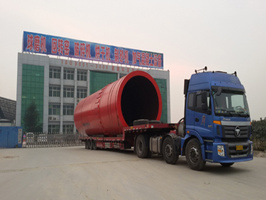
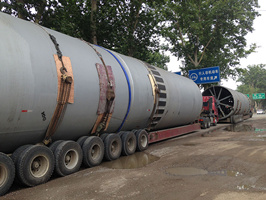
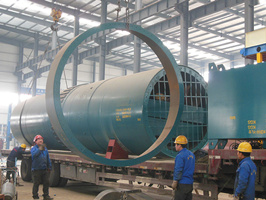
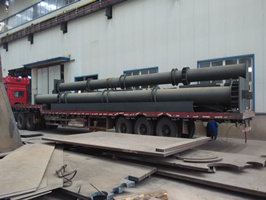
Project Case

Jinan 350TPD Lime Kiln Production Line
Attracted by lime rotary kiln manufactured by china famous rotary kiln supplier, Zhengzhou Taida, Jinan customer purchased a whole set of lime rotary kiln calcining machine to fulfill final production aim. The picture shown above presents the real working condition of Taida lime rotary kiln.
Raw material: Lime
Output capacity:350T/D

10TPH Russia Gypsum Production Site
Gypsum with high moisture is sent to hopper. Then, gypsum will enter the feeding end of rotary kiln dryer. Under this situation, the inclination of feeding end will be larger than natural inclination of gypsum.then, gypsum will enter rotary kiln dryer smoothly. calcining rotary kiln is a rotary drum with certain inclination.
Raw material:Phosphaste gypsum
Output capacity:1-10T/H
Technical Parameters
|
Specifications (m) |
Dimension | Power (kw) | Total weight (t) | Notes | ||||
| Diameter (m) | Length (m) | Inclination (%) | Output (t/h) | Rotary speed (r/min) | ||||
| Φ2.5×40 | 2.5 | 40 | 3.5 | 180 | 0.44-2.44 | 55 | 149.61 | With vertical preheater |
| Φ2.5×50 | 2.5 | 50 | 3 | 200 | 0.62-1.86 | 55 | 187.37 | ---- |
| Φ2.5×54 | 2.5 | 54 | 3.5 | 204 | 0.48-1.45 | 55 | 196.29 | ---- |
| Φ2.7×42 | 2.7 | 42 | 3.5 | 320 | 0.10-1.52 | 55 | 198.5 | ---- |
| Φ2.8×44 | 2.8 | 44 | 3.5 | 400 | 0.437-2.18 | 55 | 201.58 | Decomposition outside the kiln |
| Φ3.0×45 | 3 | 45 | 3.5 | 500 | 0.5-2.47 | 75 | 210.94 | ---- |
| Φ3.0×48 | 3 | 48 | 3.5 | 700 | 0.6-3.48 | 100 | 237 | Decomposition outside the kiln |
| Φ3.0×60 | 3 | 60 | 3.5 | 300 | 0.3-2 | 100 | 310 | Bauxite calcining kiln |
| Φ3.2×50 | 3.2 | 50 | 4 | 1000 | 0.6-3 | 125 | 278 | Decomposition outside the kiln |
| Φ3.3×52 | 3.3 | 52 | 3.5 | 1300 | 0.266-2.66 | 125 | 283 | preheat decomposition |
| Φ3.5×54 | 3.5 | 54 | 3.5 | 1500 | 0.55-3.4 | 220 | 363 | preheat decomposition |
| Φ3.6×70 | 3.6 | 70 | 3.5 | 1800 | 0.25-1.25 | 125 | 419 | Residual heat power |
| Φ4.0×56 | 4 | 56 | 4 | 2300 | 0.41-4.07 | 315 | 456 | preheat decomposition |
| Φ4.0×60 | 4 | 60 | 3.5 | 2500 | 0.396-3.96 | 315 | 510 | preheat decomposition |
| Φ4.2×60 | 4.2 | 60 | 4 | 2750 | 0.4-3.98 | 375 | 633 | preheat decomposition |
| Φ4.3×60 | 4.3 | 60 | 3.5 | 3200 | 0.396-3.96 | 375 | 583 | preheat decomposition |
| Φ4.5×66 | 4.5 | 66 | 3.5 | 4000 | 0.41-4.1 | 560 | 710.4 | preheat decomposition |
| Φ4.7×74 | 4.7 | 74 | 4 | 4500 | 0.35-4 | 630 | 849 | preheat decomposition |
| Φ4.8×74 | 4.8 | 74 | 4 | 5000 | 0.396-3.96 | 630 | 899 | preheat decomposition |
| Φ5.0×74 | 5 | 74 | 4 | 6000 | 0.35-4 | 710 | 944 | preheat decomposition |
| Φ5.6×87 | 5.6 | 87 | 4 | 8000 | Max4.23 | 800 | 1265 | preheat decomposition |
| Φ6.0×95 | 6 | 95 | 4 | 10000 | Max5 | 950×2 | 1659 | preheat decomposition |
Core Equipment
Applicable Materials
